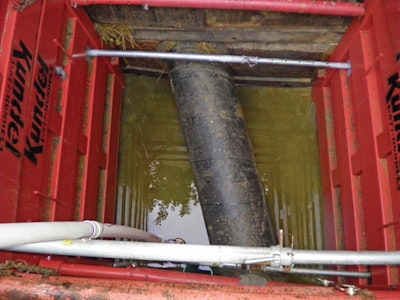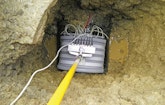
Interested in Inspection?
Get Inspection articles, news and videos right in your inbox! Sign up now.
Inspection + Get AlertsInsider knowledge at the Metropolitan Sewer District of Greater Cincinnati, Ohio, identified the Pleasant Run Central force main as one of the city’s most critical pipes. Built in 1974, the 6,945-foot line has a maximum design flow of 8,000 gpm at 90 psi.
“If the main fails, we couldn’t bypass pump fast enough to handle the flow,” says senior environmental safety specialist Cheryl Townsend-Braun. “We’d have large-scale environmental contamination through a residentially congested corridor.”
District officials wanted a condition assessment on the main to make sure it would hold up until they could build the new Great Miami Wastewater Treatment Plant and gravity sewers and eliminate the Pleasant Run Central pump station. The assessment also would estimate how soon a catastrophic failure might occur.
Malcolm Pirnie, the Water Division of ARCADIS, won the bid. Subcontractor InfraMetrix used broadband electromagnetic (BEM) scans at nine locations. The worst section of pipe had a minimum wall thickness of 0.162 inch, maximum wall thickness of 0.210 inch, and an average wall thickness of 0.186 inch. Shop drawings of the 24-inch spiral-welded steel force main stated that the original wall thickness was 0.25 inch.
A sensitivity analysis by Pirnie/ARCADIS estimated its remaining useful life was four years.
“We’ll open-cut and replace the 450-foot section this year because there is nothing we can do to lower the consequence of that force main failing,” says Townsend-Braun.
Likely candidates
To choose the nine survey locations, subcontractor Pure Technologies launched the Sahara ultrasonic probe from manhole to manhole. The hydrophone identified air pockets, bends, leaks, and sediment. At the same time, an acoustic pipe wall assessment hydrophone measured hoop stiffness and located anomalies.
“Concerns about internal corrosion downstream of 45-degree bends made them prime targets,” says Townsend-Braun. “We also wanted scans of sections with air pockets because hydrogen sulfide forms in them and may corrode the crown.”
InfraMetrix technicians did five 360-degree pipe scans and four Keyhole tool scans of the crown from 11 to 1 o’clock. Ground cover over the force main averaged six feet deep. City contractor Queen City Mechanical open-cut and shored the 8- to 10-foot-long by 8-foot-wide trenches along residential roads. The excavations extended 12 inches below the bottom of the pipe for access to the underside. Some pits required dewatering.
Badger Daylighting of Taylor Mill, Ky., used a Badger Hydrovac excavator to pothole 16-inch holes and expose 12 inches of the crown of the pipe for the Keyhole scans.
“We chose this technology for four locations because they were all in pavement and we wanted as little excavation and disturbance as possible,” says Townsend-Braun.
On the grid
For full scans, InfraMetrix technician Harlan Mitchell taped a 3-foot-wide sheet of paper with 2-inch square grids around the circumference of the pipe. The BEM uses eight 2-inch-square antennae in a 2-inch-wide metal bar with a port for the receiver cable connected to a laptop computer.
With the bar positioned on one section of the grid, InfraMetrix field supervisor David Burton induced eddy currents through the antennae and pipe. The process took about five seconds. Then Mitchell moved the antennae to the next section on the grid. Signals received at the laptop gave real-time data on wall thickness. The data was maintained in a spreadsheet with x-y location for later mapping and analysis.
“We didn’t have to clean or bypass the pipe and the process can scan through coatings or linings up to two inches thick,” says Townsend-Braun. “The response of the electrical signal is based on metal thickness and composition. Once they change, the signature changes.”
Degrees of metal loss are depicted by various colors on a graph.
Step by step
With the first scan completed, Burton moved the paper over and began again, taking 1,600 to 2,400 measurements per 5-foot section of pipe. The scans were so sensitive that steel pipe welds were easily identified on the wall thickness graph.
“We expected the welded sections to be thicker than the metal on either side, but the heat and the chemical reaction of welding altered the metal composition,” says Townsend-Braun. “The pipe is thinner at the welds and has a different signature.”
Faster, less-expensive cap scans were done with the Keyhole tool, a device that conforms to the curvature of the crown and holds eight flexible antennae. A pole raises and lowers the unit and enables the technician to apply pressure so the antennae make contact with the pipe. All other principles of the BEM scan remain the same.
“We found our best section of pipe at the cap 4 scan,” says Townsend-Braun. “It had a minimum wall thickness of 0.234 inch, maximum wall thickness of 0.244 inch, and an average wall thickness of 0.238 inch.”
Two bad actors
Based on the potential for localized perforation at four years, Pirnie/ARCADIS’s sensitivity analysis recommended that the district schedule repairs for two sewer sections immediately downstream of 45-degree bends.
Townsend-Braun often contemplated what happened to the outside bend of a pipe wall when water under pressure hit the sharp curve and had to turn. “Over time, the impact had to erode the cement lining faster than the rest of the pipe,” she says. “One reason we chose scans downstream of bends was to prove that theory, and we did.”
Based on the projected failures, the district ordered 24-inch repair clamps and stocked them at two pump stations. They will pull the old force main drawings for Pleasant Run West, identify the bend locations, mark them in GIS, and plan field investigations to locate and assess critical bends.
“The Pleasant Run West Pump Station force main has had recent point failures,” says Townsend-Braun. “We may scan it to make sure a catastrophic failure doesn’t occur while we’re building the wastewater treatment plant. After that, our risk model will drive future maintenance on other force mains.”







